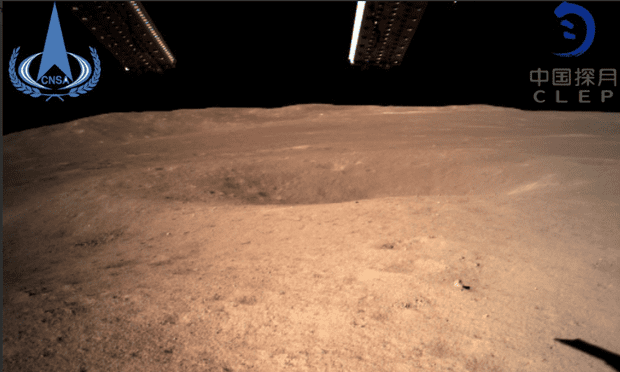
Lander sends back first close-up shot of previously unexplored side of the moon
A Chinese spacecraft has become the first ever to land on the far side of the moon, according to state-run media, in a giant leap for human space exploration.
The China National Space Administration (CNSA) landed the robotic probe Chang'e 4 in the unexplored South Pole-Aitken basin, the largest, oldest, deepest, crater on the moon's surface.
Early reports of a successful landing sparked confusion after state-run media China Daily and CGTN deleted tweets celebrating the mission. China Daily's tweet said: '"China's Chang'e 4 landed on the moon's far side, inaugurating a new chapter in mankind's lunar exploration history."
Official confirmation of the landing came two hours later via state broadcaster CCTV, which said the lunar explorer had touched down at 10.26am (2.26am GMT). The Communist party-owned Global Times also said the probe had "successfully made the first-ever soft landing" on the far side of the moon.
An image tweeted by the English-language version of CCTV showed the first close-up shot of the far lunar surface.
The mission aims to take detailed measurements of the moon's terrain and mineral composition. The Aitken basin is thought to have been formed during a gigantic collision very early in the moon's history. The collision is likely to have thrown up material from the moon's interior, meaning that Chang'e 4 could provide new clues as to how the natural satellite was formed.
The successful landing was touted as a "huge feather in China's cap" by Malcolm Davis, senior analyst in defence strategy and capability at the Australian Strategic Policy Institute.
"There's a lot of geopolitics or astropolitics about this, it's not just a scientific mission, this is all about China's rise as a superpower," said Davis. "There's a lot of enthusiasm for the space program in China. There's a lot of nationalism in China, they see China's role in space as a key part of their rise."
The landing was greeted as "an impressive accomplishment" by Nasa administrator Jim Brindestine.
A spokesperson from the Australian Space Agency said the agency did not have a comment on the mission except to offer China its congratulations on the success of the landing and to "wish them all the best".
Davis said China's successful landing could "set a fire under the Americans", who may not like the idea that the next person to set foot on the moon may be a Chinese Taikonaut, as they are unofficially called.
"I imagine we will see an announcement the Chinese do intend to send Taikonauts to the moon by 2030," said Davis.
Chang'e 4 entered an elliptical path around the moon at the weekend, drawing as close as 15km (9 miles) from the surface.
Spacecraft have taken pictures of the moon's far side before, but no lander has ever touched down there. The move marks a step towards China's ambition to become a leading power in space exploration alongside the US and Russia.
Davis said China's extraterrestrial ambitions seemed to be driven by multiple factors, including a desire for military dominance of space. Other motivations include the access to vast resource wealth provided by the moon and asteroids, in particular Helium-3 which is believed to exist in great abundance on the moon, and also that dominance of the region would be a sign of China's growing power.
"China has been very clear in its understanding of this. They have compared the moon to the South China sea and Taiwan, and asteroids to the East China sea. They're making a very clear geopolitical comparison with what's happening with space and we need to pay attention to that."



Reader Comments
to our Newsletter